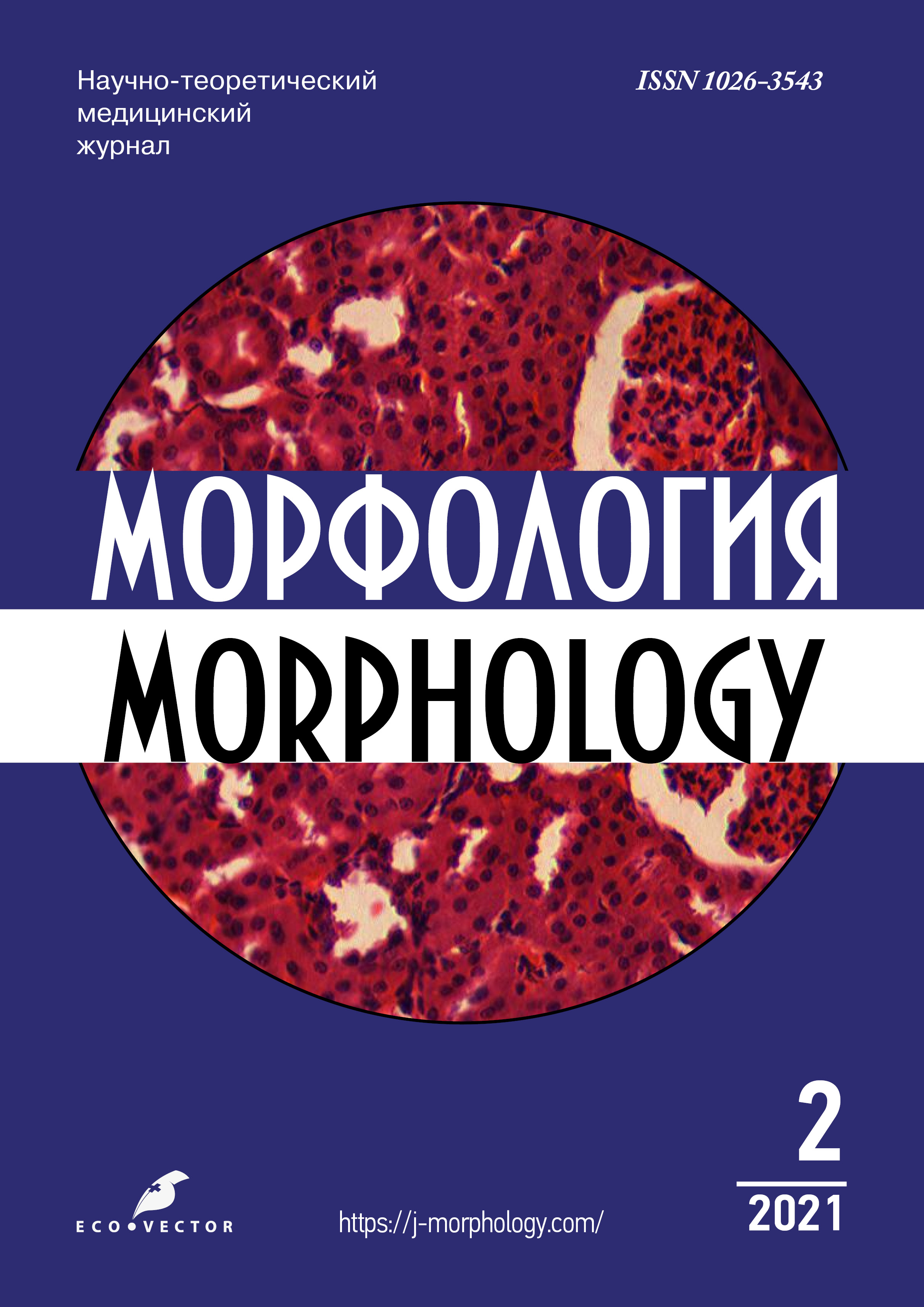Том 159, № 2 (2021)
- Год: 2021
- Выпуск опубликован: 01.08.2021
- Статей: 4
- URL: https://j-morphology.com/1026-3543/issue/view/5512
- DOI: https://doi.org/10.17816/morph.20211592
Весь выпуск
Оригинальные исследования
Влияние экспериментального сахарного диабета у самок крыс на морфофункциональные характеристики сперматогенного эпителия у потомства
Аннотация
Цель. Анализ морфофункционального состояния сперматогенного эпителия у потомства самок крыс с экспериментальным сахарным диабетом.
Материал и методы. Исследования проведены на белых лабораторных крысах Вистар (самках), на которых моделировали сахарный диабет 1 типа, и их 70-дневном потомстве. Воспроизводство сахарного диабета осуществлялось по общепринятой методике с помощью стрептозотоцина. На серийных гистологических препаратах семенников потомства матерей с диабетом определяли площади паренхимы и стромы, число и площади семенных извитых канальцев, суммарное содержание сперматогенных клеток и их субпопуляционного состава, количество сустентоцитов из расчёта на один извитой семенной каналец. Проводилось определение ряда общепринятых индексов, в том числе индекса сперматогенеза, индекса релаксации сперматогенеза, герминативного индекса.
Результаты. Установлено, что у потомства самок крыс с экспериментальным сахарным диабетом имеет место уменьшение площади паренхимы семенника и увеличение площади его стромы, снижено суммарное содержание сперматогенных клеток, в том числе сперматогоний, сперматоцитов 1 и 2 порядка и сперматид, что обусловливает уменьшение содержания сперматозоидов. Полученные результаты согласуются со снижением индекса сперматогенеза у потомства самок крыс с экспериментальным сахарным диабетом. Исследование содержания у экспериментальных животных сустентоцитов не выявило существенных различий, однако анализ величины герминативного индекса и индекса релаксации сперматогенеза позволил установить существенное снижение этих показателей у подопытных животных по сравнению с контролем.
Выводы. У самок крыс с экспериментальным диабетом рождается потомство с нарушением генеративной функции семенников.
 47-53
47-53


Характеристика антропометрических показателей компонентного состава тела подростков в норме и при синдроме вегетативной дисфункции
Аннотация
Цель. Изучить антропометрические показатели и компонентный состав тела у подростков в норме и при синдроме вегетативной дисфункции (СВД) методами антропометрии и биоимпедансометрии.
Материалы и методы. В исследовании приняли участие практически здоровые подростки и подростки с СВД ваготонического, смешанного и симпатикотонического типа. Оценивались значения основных антропометрических (длина и масса тела, обхват талии и бёдер) и биоимпедансометрических показателей (абсолютные и относительные значения жировой, безжировой, скелетно-мышечной и активной клеточной масс). Произведён расчёт индекса массы тела Кетле и индекса талия-бедра. Проведён статистический анализ данных.
Результаты. В группе подростков с ваготоническим типом СВД установлены низкие значения антропометрических показателей, индексов и абсолютных значений жировой, безжировой, скелетно-мышечной масс и высокие значения активной клеточной массы по сравнению с другими группами обследованных подростков. У подростков с симпатикотоническим типом СВД выявлены высокие значения антропометрических показателей, индексов и абсолютных значений жировой, безжировой, скелетно-мышечной масс и низкие значения активной клеточной массы. Значения изучаемых показателей в группах здоровых подростков и подростков с СВД смешанного типа занимают промежуточное положение по сравнению с группами при ваготоническом и симпатикотоническом типах.
Заключение. Выявлены статистически значимые различия значений абсолютных и относительных показателей, характеризующих компонентный состав тела, у практически здоровых подростков и подростков при различных типах синдрома вегетативной дисфункции.
 55-62
55-62


Сравнительный анализ морфологических изменений коркового вещества почек у крыс в условиях экспериментального светового десинхроноза
Аннотация
Цель. Сравнительный анализ морфологических изменений, возникающих в ткани почки в результате развития светового десинхроноза.
Материал и методы. Исследование проведено на 48 белых крысах. Три подопытные группы подвергались световому воздействию в течение 21 сут, при этом модель LL (0:24) изучалась на 1-й группе, модели LD 18:6 и 12:10 – на 2-й и 3-й группах соответственно. Контрольная группа находилась в естественных условиях на протяжении всего эксперимента. Животные были выведены из эксперимента комбинацией препаратов Телазол (ZoetisInc, США) и Ксиланит (Нита-Фарм, Россия), после чего у них проводился забор правой почки. Препараты готовили по стандартной методике.
Статистическую обработку проводили с использованием пакета прикладных статистических программ «STATISTICA 10» (StatSoft®, США).
Результаты. Установлено, что в условиях светового десинхроноза в корковом веществе почек экспериментальных животных происходят патоморфологические изменения. У животных 1-й экспериментальной группы происходит значительная сегментация клубочков и дистрофические изменения в канальцах почек. Во 2-й подопытной группе сегментация клубочков становится более выраженной. В ткани почек животных 3-й подопытной группы отмечаются визуально более выраженные нарушения и очаги склероза. Изменения морфометрических показателей носили значимый характер во всех экспериментальных группах.
Выводы. Световой десинхроноз вызывает патоморфологические изменения в корковом веществе почек крыс. Наиболее значимые нарушения, носящие характер склероза, отмечены в почках животных третьей подопытной группы.
 63-70
63-70


Научные обзоры
Постнатальный нейрогенез в головном мозгу человека
Аннотация
В настоящее время накоплен богатый материал о нейрогенезе в головном мозгу взрослого человека. И если в генетике появляется всё больше данных, не только доказывающих, но и подробно описывающих молекулярные механизмы данного явления, в морфологии имеются работы, оспаривающие обновление нейронов в зрелом возрасте. В связи с этим в обзоре представлены современные достижения эпигенетики, морфологии и физиологии, подтверждающие и подробно характеризующие постнатальный нейрогенез. Сделано предположение, что внедрение молекулярно-генетических технологий в морфологические исследования стало бы отправной точкой для интеграции данных направлений, взаимодополняющих друг друга для использования полученных результатов в клинической практике. Получены многочисленные доказательства наличия постнатального нейрогенеза у взрослого человека в исследованиях с бромдезоксиуридином, радиоизотопом углерода 14С и 3Н-тимидина, сравнительным анализом с экспериментальными данными на животных. Нейрональные стволовые клетки, представленные радиальной глией в субвентрикулярной и субгранулярной зонах головного мозга человека, морфологически сходны с нейроэпителиальными клетками. Они экспрессируют маркерные для астроцитов белки, и это позволяет утверждать, что обнаруживаемая у взрослых людей пролиферация нейроглии может свидетельствовать также об обновлении нейронов. Для доказательства этого необходимы дальнейшие исследования с точной идентификацией вновь образуемых клеток с использованием специфических молекулярных маркеров и данных современной эпигенетики. Интеграция методов молекулярной генетики в морфологию даст возможность не только точно определять принадлежность клеток к определённой субпопуляции, но исследовать влияние различных агентов на пролиферацию нейронов взрослого человека.
 37-46
37-46













